- What Is Anime?
- Why The Big Eyes?
- Why So Many Women?
- What's With The Hair Colors and Styles?
- Why Is Anime Sometimes So "Naughty"?
- Where Can I Learn More?
Anime, often known as Japanimation, is a collective term for
"cartoon" art drawn in a certain style, and demonstrating certain
common characteristics. Anime refers primarily to video, or full motion
art, while manga is the "comic book" or still version of art drawn in
the same style. It is common to see the term anime used to encompass manga
art as a universal term. Anime is a very diverse art form, ranging from
space operas to love stories, comedies, high fantasy, action-adventure, and even
pornography. Some well known anime are Sailor Moon, G-Force, Star Blazers,
and Dragonball Z. These are but the tip of the iceberg, however...
One of the first questions I am always asked by those I
introduce to anime is "Why do the characters all have such big
eyes?" Well, this issue is a matter of some conjecture, but in
general the answer has to do with the expressive nature of the eyes. A
great deal of emotion can be portrayed easily with the eyes, and in anime, the
most caring, emotional characters often have the largest eyes, while criminals,
fools, and evil doers usually have much smaller eyes. Here is an
example...
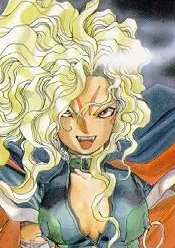 |
This is Mara, a demonic
character in the wonderful anime/manga series Ah! My Goddess (Aa! Megami
Sama). While she is drawn to be pretty, or sexy if you prefer, and
still has larger eyes than a true to life human figure, they are much
smaller, and more slanted than those of the good goddesses she faces off
against.
You can often tell who is a "bad guy" or foil by looking at
how the eyes are drawn. A character with smaller, slanted, or
obscured eyes is usually an antagonist, or up to no good. |
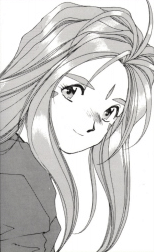 |
This is
Belldandy, the lovable and charming heroine of the series. She is
a very thoughtful and deeply caring person, and though this picture does
not show it to full advantage, has very large expressive eyes.
Compare her to Mara and I think you will see what I am referring to.
Sometimes the size of a character's eyes can
vary, and often if they are very happy, sad, or contemplative, their
eyes will be larger than usual, and when they are angry or up to no
good, their eyes may get noticeably narrowed.
As a side note, eye color is no indication of
personality, and often outrageous colors such as gold or violet are used
as freely as blue or brown. |
It is true that in perhaps 90% of anime series, the
lead characters are all female. As a male I don't find much to complain
about in this regard, but it is surely a valid question. It is NOT because
the bulk of anime viewers in Japan are male. It is also interesting
to note that while gender equality in Japan is rather advanced, there are also a
great many traditional roles in Japanese society which mandate certain duties
and stations to men or women alone. Anime, then, does not neccessarily
reflect Japanese culture.
I honestly cannot give you a definitive answer to this
one!
Anime often features characters with brightly colored
hair, some of which defies the laws of physics in the way it is styled.
This is a reflection on Japanese pop culture, in which individuality is often
achieved by styling one's hair in outrageous fashion or coloring it. I
suppose in a country where 999 out of every 1000 people have black or brown
hair, it stands to reason. Here are a couple examples:
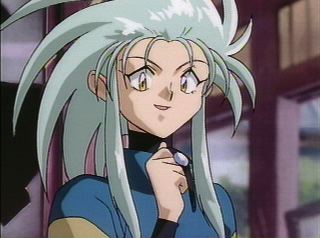 |
Here is
another of my favorite characters, Ryoko, this time from Tenchi Muyo.
Her hair is not only greenish-gray, but spikey and puffed out beyond
what the picture even shows. Imagine the gel and mousse you would
need to replicate such a hairstyle in real life!
You might note that Ryoko has gold eyes, an
example of the many odd colors anime characters often display. |
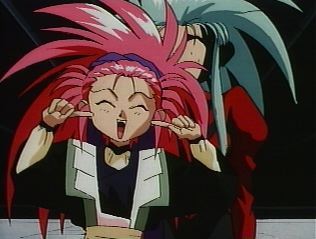 |
This
pink-haired character is Washu, also from Tenchi Muyo. Though she
looks young in the picture, she is actually a super-genious scientist
and the creator of Ryoko, who can be seen in the background (partially
obscured). You might note the similar hair styles, a subtle hint
at their relationship.
Bright pink, green, and blue are common hair
colors for anime ladies. Often, a character without outrageous
hair looks out of place in a series! |
Anime artists are not afraid to show some nudity or
hint at sexual relationships in even the most generally innocent series like
Tenchi Muyo and Ah! My Goddess. It is quite common for bathing
scenes, super-suit transformations, and cut scenes to feature a bit of
nudity. While this "fan service" as it is called is usually kept
to PG levels it can get down right raunchy in titles designed to be that way,
such as LA Blue Girl, and others.
There are two terms used to describe
"naughty" anime, and one to describe naughty manga. Hentai and
Ecchi both refer to sexually explicit or graphicly nude art appealing to the
dirty minded :-). The term Doujinshi is used for sexually oriented manga
art.
Most of what you will see looks like this:
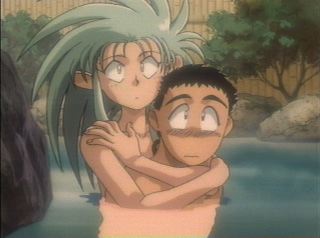 |
While
Ryoko and Tenchi of Tenchi Muyo are both apparently nude, there is no
graphic display of genitalia or sexual activity.
Anime fans are sharply divided on the place of
Hentai, or truly explicit materials within the artform. I believe
that excluding certain subject matter for the sake of censorship dilutes
the art, but others feel that inclusion of nudity and sex cheapens
it. You can decide for yourself...click here
to see a much more revealing image. |
I am happy to see that you want to know more about
anime! Click here to go to the second section of
my FAQ, which is a lot more in depth on things to notice when watching anime, as
well as some titles you may want to try and track down.
Chris "Badger" Buswell.
Copyright © 1999 [Furry-Fury Productions]. All rights reserved.
Revised: July 27, 1999
.




